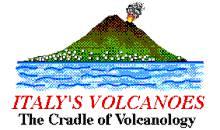| Stromboli
home page |
||
| Eruptive history | Volcanic hazards | References |
| Eruptive characteristics | Geophysical monitoring | Web sites |
| Latest news | ||
Eruptions before
A.D. 79
Vesuvio's eruptive history prior to the AD 79 eruption is not historically documented, and only the major explosive (Plinian) events have been reconstructed fairly well in recent years. It is known that during the past ~25,000 years, the volcano has had eight Plinian eruptions, three of them during the Holocene: "Ottaviano", or "Mercato" (~8000 BP), "Avellino" (~3750 BP) and "Pompei" (AD 79). The intervening activity is relatively poorly constrained but there appear to have been periods of prolonged or intermittent, small to moderate scale activity similar to that after the AD 79 and 1631 eruptions, as well as several sub-Plinian (A.D. 472 or 1631 size) events. Much still has to be learned. A forthcoming issue of the Journal of Volcanology and Geothermal Research will be dedicated to Somma-Vesuvio, with an emphasis on the earlier (pre-AD 79) history of the volcano.
The Plinian events before AD 79 will be described in short summaries in the following, based mainly on Santacroce (1987), Rolandi et al. (1993b, 1993c), and going stratigraphically upwards.
1) 25,000 BP "Codola" Plinian eruption
2) 22,500 BP "Sarno" Plinian eruption
3) 17,000 BP "Basal" Plinian eruption
4) 15,500 BP "Greenish" ("Verdoline") Plinian eruption
5) 11,400 BP "Lagno Amendolare" Plinian (?) eruption
6) 8000 BP "Mercato" or "Ottaviano" Plinian eruption
7) 3750 BP "Avellino" Plinian eruption
The "Avellino" eruption was
very similar to the AD 79 "Pompei" eruption,
regarding erupted volumes and the course of eruptive phases. The initial
activity was violently phreatomagmatic and produced pyroclastic surge
and phreatoplinian deposits. A Plinian phase ensued, ejecting almost 3
km^3 of pumice, initially more evolved white and grading upwards into
more mafic gray pumice. Fallout occurred in a sector ENE of the volcano,
leaving a deposit more than 50 cm thick at Avellino, about 35 km from
Vesuvio. Close to the volcano, on its NE slope, the fall deposits are
up to 3 m thick.
Rolandi et al. (1993b)
calculated maximum eruption column heights in excess of 35 km during the
culminating phase (the ejection of gray pumice). At the end of this phase,
a pyroclastic flow formed by column collapse, ravaging the W flank of
the volcano. However, a much larger quantity of flow deposits was emplaced
as pyroclastic surges during the hydromagmatic stage following the Plinian
activity. Surge deposits are more than 10 m thick on the WNW slope of
the volcano, up to 4 km from the crater, and are at least 1 m thick in
the present center of Napoli. Thin surge deposits extend beyond the municipal
area of the city to the W and NW. The volume of tephra erupted as pyroclastic
surges is about 1 km^3.
The presence of thick surge deposits in the urban area of Napoli has important
hazards implications. Even though the magnitude of Vesuvian eruptions
seems to be strongly correlated to the preceding repose periods, and therefore
a new Avellino or Pompei sized eruption will likely occur only after many
hundreds to thousands of years of repose, there is a good possibility
that Vesuvio will again cover the area of the present town of Napoli with
surges in the future.
Copyright © Boris Behncke, "Italy's Volcanoes: The Cradle of Volcanology"
